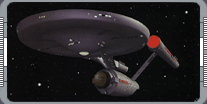
U.S.S. Enterprise NCC-1701
The Constitution-class
U.S.S. Enterprise NCC-1701 is one of the most famous ships in
the history of Starfleet.
 The USS Enterprise NCC-1701 was a Constitution-class starship that was in service between 2245 and 2285.
It was designed for deep space exploration and had an extremely distinguished career under five captains
- Robert April, Christopher Pike, James T. Kirk, Willard Decker and Spock.
The USS Enterprise NCC-1701 was a Constitution-class starship that was in service between 2245 and 2285.
It was designed for deep space exploration and had an extremely distinguished career under five captains
- Robert April, Christopher Pike, James T. Kirk, Willard Decker and Spock.
Under Pike's command, the Enterprise was known as a Starship-class spaceship, but by the time Kirk
took command in 2263, the classification had changed and the Enterprise had become one of 12 Starfleet
vessels known as the Constitution-class starships. The Enterprise was 289 meters in length and had 23
decks. It was fitted with state-of-the-art equipment and had facilities that were equal to anything
found on a starbase. Early in its career it had a crew of 203, but by the 2260s the ship's complement
had risen to 430. The Enterprise's mission objectives included exploring unknown space, making first
contact with alien races, supplying Federation colonies, delivering medical supplies, transporting
diplomats, and defending Federation space. Because a major part of its mission involved scientific
research, the Enterprise had a total of 14 science labs. It was equipped with advanced medical
facilities which included a full surgery and a medical research lab. The crew consisted of a number of
mission specialist, including botantists, historians, psychologists and tactical experts. The ship's
computers, which employed duotronic circuitry, were extremely powerful, and had access to a vast
database of information.
Starfleet has always tried to avoid armed conflict, but the Enterprise was designed to defend itself.
It was protected by deflector shields, and had an impressive weapons arsenal that included both phasers
and photon torpedoes, the latter of which had an effective range of 750,000 kilometers. The ship was
also equipped with tractor beams that could take smaller ships in tow. Constitution-class ships were
not designed to enter a planet's atmosphere, so the Enterprise relied on its transporters to send
personnel to and from the surface of a planet. The Enterprise carried small shuttlecraft such as the
Galileo for those occasions when the use of
transporters was not possible. The shuttles could carry up to 24 passengers for limited journeys.
Constitution-class ships were powered by matter-antimatter engines focused through dilithium crystals.
Two warp engine nacelles supported by pylons extended from the engineering hull to provide the
faster-than-light speeds, while at the stern of the saucer section were impulse engines that propelled
the ship at sublight speeds. In an emergency, the warp nacelles could be disengaged; if necessary, the
saucer section could be separated from the engineering hull.
 Back-up power was available if the matter-antimatter engines broke down; the Enterprise could also run on
battery power for about a week, depending on which subsidiary systems were used. The Enterprise crew
often spent extended periods in space, and the ship was thus designed with their comfort in mind. Even
junior crew members, such as yeomen, had private quarters and there were recreational areas where the
crew could gather for meals and to amuse themselves. The Enterprise was normally controlled from the
bridge at the top of the saucer section, but control of essential systems could, if necessary, be
rerouted to engineering or the auxiliary control room. The Enterprise underwent several refits during
its 40 years of service, including one major service in 2271 during which the ship was almost completely
rebuilt. It was sadly destroyed in 2285 when Captain Kirk was forced to activate the self-destruct
system to prevent the ship from falling into Klingon hands.
Back-up power was available if the matter-antimatter engines broke down; the Enterprise could also run on
battery power for about a week, depending on which subsidiary systems were used. The Enterprise crew
often spent extended periods in space, and the ship was thus designed with their comfort in mind. Even
junior crew members, such as yeomen, had private quarters and there were recreational areas where the
crew could gather for meals and to amuse themselves. The Enterprise was normally controlled from the
bridge at the top of the saucer section, but control of essential systems could, if necessary, be
rerouted to engineering or the auxiliary control room. The Enterprise underwent several refits during
its 40 years of service, including one major service in 2271 during which the ship was almost completely
rebuilt. It was sadly destroyed in 2285 when Captain Kirk was forced to activate the self-destruct
system to prevent the ship from falling into Klingon hands.
|
|
"U.S.S. ENTERPRISE NCC-1701" - JULY 1999 ISSUE 3 STAR TREK: THE MAGAZINE COPYRIGHT OF PARAMOUNT PICTURES.
|